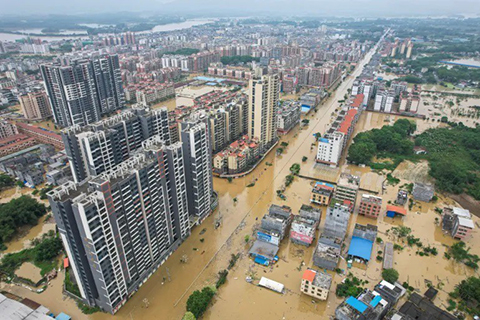Floods have caused so much damage that China has raised the flood warning to its highest level in many parts of Guangdong.
Many areas in Guangdong province were severely flooded. Photo: SCMP
Floods have killed at least four people and left 10 others missing in southern China, and more than 110,000 people have been evacuated along the Beijiang River, a tributary of the Pearl River, due to the risk of flooding and landslides, officials in Guangdong province said on April 23. Heavy rains in southern China show no signs of abating, so the flooding is likely to be more dangerous in the coming days. Guangdong usually experiences heavy rains and floods around September every year. But in recent years, the rainy season in Guangdong has come earlier and lasted longer.
China's State Flood Control and Drought Relief Headquarters recently extended the level-3 flood emergency response in Guangdong Province. The extension of the flood emergency response in Guangdong Province is aimed at ensuring the safety of more than 127 million people there.
China's Ministry of Emergency Management said that authorities have deployed technical equipment to inspect and assess the current state of dikes and embankments in Guangdong Province and prepare flood control and relief measures. The Ministry of Emergency Management has called on its working groups in Shaoguan and Qingyuan in the region to provide support and guidance in flood response.
China has a four-tier flood control emergency response system, with level 1 being the most severe and urgent response. On April 19, the State Flood Control and Drought Relief Headquarters activated a level 4 emergency response for possible flooding in Guangdong, Guangxi and Jiangxi. However, the flood response level was raised to level 3 a few days later. The warning was issued after persistent heavy rains caused water levels in some major rivers and reservoirs in Guangdong to rise to their highest levels in 50 years.
According to local media, heavy rains in recent days have caused flooding in many areas of Guangdong province, power outages in many places, and temporary closures of kindergartens, primary and secondary schools...
In addition, many hydrological stations in Guangdong Province have recorded water levels exceeding the threshold. Data shows that 2,609 hydrological stations have recorded daily rainfall greater than 50mm, accounting for about 59% of the total number of monitoring stations. Of these, 27 hydrological stations in Guangdong Province have been placed on alert.
In neighboring Guangxi Province, west of Guangdong Province, fierce winds and heavy rains swept through the region, causing damage to buildings. Some areas also suffered hail and heavy flooding, state media CCTV reported. More than 65 landslides were reported in the city of Hezhou, Guangxi Province.
China faced heavier and more intense rains during the flood season in 2023 than in previous years, with 72 national weather stations recording record daily rainfall and 346 stations breaking monthly records, according to the China Meteorological Administration.
China's Ministry of Water Resources believes that the reason floods in the country increase every year is because global warming leads to extreme weather such as prolonged hot weather, continuous heavy rain... causing flooding in many places.
Currently, the flood situation has shown signs of slowing down, however, the lives of tens of thousands of people in China are still facing difficulties. It is worrying that although it is only the beginning of the rainy season, the flood has risen to an alarming level, so when the rainy season peaks (around September every year), it is likely that floods in China will be much more dangerous if there are no proactive solutions.
HN synthesis
Source





![[Photo] T&T 1 and Ho Chi Minh City 1 People's Police Teams won the men's and women's team championships](https://vphoto.vietnam.vn/thumb/1200x675/vietnam/resource/IMAGE/2025/5/22/39db06ae67cb4001b7a556e8d9a56d07)




















































































![[Podcast] Week introducing more than 500 OCOP products in Hanoi](https://vphoto.vietnam.vn/thumb/402x226/vietnam/resource/IMAGE/2025/5/22/d144aac2416744718388dbae3260e7fd)

Comment (0)